One of the selling points of the ASUS Tinker Board is its performance, so we ran Geekbench 4 on TinkerOS Android (since we were able to install it…) to see how it shapes up. Geekbench contains a range of synthetic tests that are designed to simulate the kind of loads you will encounter during everyday tasks. The CPU test outputs a single-core and a multi-core result.
The GPU test uses the Android RenderScript API to assess graphics performance. Although the test is synthetic, RenderScript is the API that Android devices use to accelerate 3D rendering and CPU compute tasks, so testing it gives a good assessment of graphics ability with real Android apps that use GPU acceleration.
The Geekbench CPU scores of 773 single-core and 1,714 multi-core don't really compete with the latest high-end phones, but then this is a sub-£50 board and these devices cost 5-10 times as much, albeit with lots of extra bits included like a high-resolution screen. The real comparison is with the Raspberry Pi 3 Model B.
We didn't have one to hand, but plenty of Geekbench 4 results are available on the Geekbench website's results browser, so here is one of the best we could find:
The ASUS Tinker Board was 58 per cent faster in single-core mode and 35 per cent faster in multi-core mode. So you are getting a similar amount of extra performance as the extra cost of an ASUS Tinker Board over a Raspberry Pi 3 Model B.
The RenderScript score of 1589 is similarly behind top-end smartphones as the CPU score. But it's not so far behind to rule the Tinker Board out from being able to run GPU-accelerated Android games. The Samsung Galaxy S7, for example, is 74 per cent quicker. That's significant, but not necessarily a deal breaker.
We couldn't find a Raspberry Pi 3 RenderScript score for comparison. In theory the Android Things build that is built for the Pi 3 will run RenderScript, despite its GPU not having explicit support, but we haven't discovered any performance results using it yet.
 KitGuru KitGuru.net – Tech News | Hardware News | Hardware Reviews | IOS | Mobile | Gaming | Graphics Cards
KitGuru KitGuru.net – Tech News | Hardware News | Hardware Reviews | IOS | Mobile | Gaming | Graphics Cards


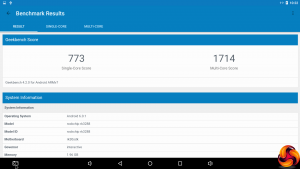
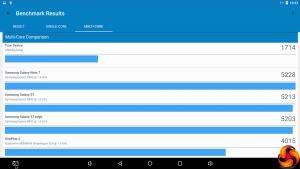
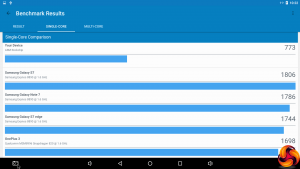
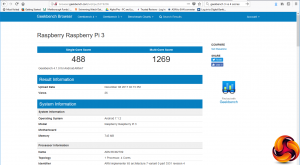
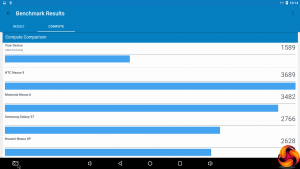

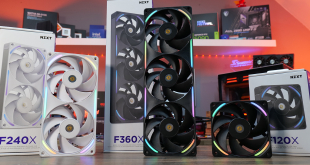
Arrr… Raspberry Pi 3 top result compared https://browser.geekbench.com/v4/cpu/compare/3061317?baseline=5408809 Not best result for RK3288. Google’s OP1 actually RK3288 also https://browser.geekbench.com/v4/cpu/compare/5060917?baseline=5408809 better performance… Ho… Ho…
See https://www.ossblog.org/installing-google-play-store-asus-tinker-board/ , where Steve Emms published an article on performing the Googleplay installation back in May 2017 (well over 7 months ago now, back about 2 months after I first received my Tinkerboard).
The only real problem I’ve found with the Tinkerboard, from the perspective of a system developer, is that the Android image is not certified properly to allow it to use HDCP, which negates it’s ability to run apps that use HDMI copy-protection on hardware that doesn’t support it –such as Comcast’s Xfinity app, used to watch cable channels over IP.
Everything else I’ve ran on this board, under Android, has been blazing fast –including Kodi 17.6.
I took a good long look over Asus’s release of Debian (called TinkerOS), and realized very quickly that their in-house Linux dev team were clueless about making a solid Linux. I replaced that install with Armbian and it worked beautifully. There were no real issues worth mentioning –at least not anything that the average Linux user would be surprised by or have any trouble working around.
I’ve kept my Tinkerboard running on Android, with Googleplay, Youtube, and several other GAPPS automatically updating correctly since May 20th when I did the final build for my board. Since I launched that system, it’s been paired with a 23″ Dell touch screen (w/ 10-pt multitouch), and works for us like a giant tablet. Its roughly twice the speed of the RPi3 on just CPU/ram-speed alone, and combined with Gbit eth0, this is one of the fastest ARM based boards I’ve ever used.
Personally, I’d recommend this board to anyone with the experience to know what to do with it. For those that aren’t quite there yet, spend more time with RPI3 boards and Linux on x86/x64; this will help you gain the troubleshooting skills you’ll need for working with these sorts of environments.
Right now, the Tinkerboard is my personal board of choice for high speed embedded projects, but I’m not depending on Asus to supply me with OS code, so that may make quite a bit of difference in my case –but really, that’s how RPi boards are too… the best OS image releases tend to be 3rd party images, or the ones built by experts for their own projects. In terms of real world performance (rather than artificial results generated from simulated workloads), I’ve had no issues with mine at all.
Oh, and Eleduino makes some great all-aluminum cases that fit both Tinkerboard and RPi2/3; I nailed down 3 of them, and used 1 of the 2 I ordered in Piano-black for my Tinkerboard. Surprisingly, the black cases were cheaper ($13) compared to the anodized (silver) aluminum models by $5 ($18 for the silver cases), but they worked interchangeably and shed heat like a big heatsink so I’ve needed no fans at all.
That was an awesome review. Thank you.
Thanks for your detailed comment! I did try the Emms Google Play install, but it didn’t work. Not sure what I was doing wrong. It actually completely borked my Android install so I had to revert to the original image again.
Seems the Android version makes a big difference.
It *wasn’t* an easy process, at all. But I think in that original discussion I’d posted, there were notes further down that allude to the debugging work we did to get it working right on a single installation run. I’m at work now, but I’ll be home soon… and will try to remember to look over that info, gather it together into a concise document and publish it somewhere as a howto.